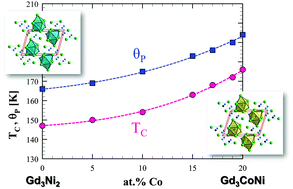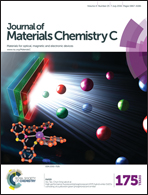Gd3Ni2 and Gd3CoxNi2−x: magnetism and unexpected Co/Ni crystallographic ordering†
Abstract
The crystal structure, composition and physical properties of Gd3Ni2, which was earlier reported to exist in the Gd–Ni system without any details of its structure and properties, have been determined. This rare earth binary compound is a high-temperature phase: it forms via a peritectic reaction at 988 K (715 °C) and decomposes below ≈923 K (650 °C). The compound can be retained at room temperature as a metastable phase by quenching after high temperature annealing. Gd3Ni2 crystallizes in the monoclinic Dy3Ni2 structure type [mS20, C2/m (No. 12), Z = 4; with lattice parameters a = 13.418(3) Å, b = 3.720(1) Å, c = 9.640(2) Å, β = 106.250(3)°]. Ni can be substituted by Co up to 50% (i.e. up to and including Gd3CoNi) with no change in the structural prototype; the substitution of Co for Ni stabilizes the R3CoxNi2−x phases down to room temperature. The crystal structure, magnetic properties and magnetocaloric effect (MCE) have been investigated for both Gd3Ni2 and the related Gd3CoxNi2−x solid solution alloys (0 ≤ x ≤ 1). The crystal structure of the Gd3CoNi is a ternary ordered derivative of the monoclinic Dy3Ni2-type, where Co fully occupies only one of the two 4i Wyckoff sites available for the transition metal. To the best of our knowledge, this is the first example of an intermetallic phase showing ordered site occupations by the chemically quite similar elements Co and Ni. All compounds show long range ferromagnetic ordering, with TC progressively increasing from 147 K (for Gd3Ni2) to 176 K (for Gd3CoNi) as a cubic function of the Co content. Evidence of Co contributing to the magnetic interactions in these compounds has been found. First-principles total energy calculations predicted the ordered occupation of Co and Ni at the crystallographic sites of Gd3CoNi, which was later confirmed by single crystal X-ray diffraction. The increased conduction electronic state (3d) exchange splitting at the Fermi level supports the experimentally observed enhanced Curie temperature in Gd3CoNi compared to Gd3Ni2.



 Please wait while we load your content...
Please wait while we load your content...